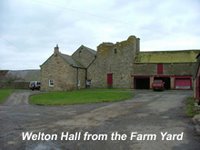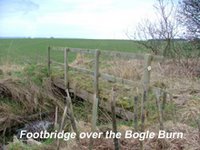This morning I walked over to Ovingham and up through Whittle Dene Woods as far as the A69. As I gazed across the busy road I was reminded of a local legend that has grown up around this place, the legend of Long Lonkin.
Just to the north about ten yards from the road and concealed by trees is the spot where, in 1215, Philip de Ulecote, a Royal Forester of Northumberland started to build a tower. As this fortification would overlook his castle at Prudhoe, the Lord of Prudhoe, Richard de Umfreville, objected to its building (The Umfrevilles would later successfully oppose the building of another castle at Bywell). Building was halted and the tower gradually became a ruin. Time passed, nobody can say for sure how long, and the ruins became the hide out of a notorious local villain named Long Lonkin. Longkin’s CV included robbery and murder but it was for his last villainous deed that he became the subject of local legend.
Just a couple of miles to the north of Lonkin’s lair, stood, as it still does today, the pele tower of Welton Hall. Lonkin had targeted the Hall for a robbery and laid his plans meticulously. By forming a relationship with a female servant from the hall he ensured that he had an accomplice on the inside and, on a night when he knew the master of the hall to be away, he put his plan into action. Let into the hall by his partner in crime, Lonkin proceeded to ransack the place in search of things to steal. Unable to find anything of value, Lonkin awoke the mistress of the Hall and demanded to be told where the valuables were kept. She refused and Lonkin justified his villainous reputation by killing her along with her young child and throwing their bodies into a nearby burn. Thwarted, Lonkin returned to his hide out to brood and to plan further acts of villainy.
forming a relationship with a female servant from the hall he ensured that he had an accomplice on the inside and, on a night when he knew the master of the hall to be away, he put his plan into action. Let into the hall by his partner in crime, Lonkin proceeded to ransack the place in search of things to steal. Unable to find anything of value, Lonkin awoke the mistress of the Hall and demanded to be told where the valuables were kept. She refused and Lonkin justified his villainous reputation by killing her along with her young child and throwing their bodies into a nearby burn. Thwarted, Lonkin returned to his hide out to brood and to plan further acts of villainy.
Just to the north about ten yards from the road and concealed by trees is the spot where, in 1215, Philip de Ulecote, a Royal Forester of Northumberland started to build a tower. As this fortification would overlook his castle at Prudhoe, the Lord of Prudhoe, Richard de Umfreville, objected to its building (The Umfrevilles would later successfully oppose the building of another castle at Bywell). Building was halted and the tower gradually became a ruin. Time passed, nobody can say for sure how long, and the ruins became the hide out of a notorious local villain named Long Lonkin. Longkin’s CV included robbery and murder but it was for his last villainous deed that he became the subject of local legend.
Just a couple of miles to the north of Lonkin’s lair, stood, as it still does today, the pele tower of Welton Hall. Lonkin had targeted the Hall for a robbery and laid his plans meticulously. By
 forming a relationship with a female servant from the hall he ensured that he had an accomplice on the inside and, on a night when he knew the master of the hall to be away, he put his plan into action. Let into the hall by his partner in crime, Lonkin proceeded to ransack the place in search of things to steal. Unable to find anything of value, Lonkin awoke the mistress of the Hall and demanded to be told where the valuables were kept. She refused and Lonkin justified his villainous reputation by killing her along with her young child and throwing their bodies into a nearby burn. Thwarted, Lonkin returned to his hide out to brood and to plan further acts of villainy.
forming a relationship with a female servant from the hall he ensured that he had an accomplice on the inside and, on a night when he knew the master of the hall to be away, he put his plan into action. Let into the hall by his partner in crime, Lonkin proceeded to ransack the place in search of things to steal. Unable to find anything of value, Lonkin awoke the mistress of the Hall and demanded to be told where the valuables were kept. She refused and Lonkin justified his villainous reputation by killing her along with her young child and throwing their bodies into a nearby burn. Thwarted, Lonkin returned to his hide out to brood and to plan further acts of villainy. On his return, and learning what had transpired in his absence, the master of the Hall, swearing
 his revenge set out to find Lonkin and administer justice. What happened next is unclear, some say that during a chase Lonkin fell into a burn and was drowned. Others say that he was caught and hanged! The fate of his accomplice, the female servant is unknown.
his revenge set out to find Lonkin and administer justice. What happened next is unclear, some say that during a chase Lonkin fell into a burn and was drowned. Others say that he was caught and hanged! The fate of his accomplice, the female servant is unknown.About a mile south of Welton Hall flows the Bogle Burn. 'Bogle' or 'Boggle', in old Northumbrian dialect is a ghost or evil spirit. Along the Bogle Burn is a deep pool called the Whirl Dub, said to be the last resting place of Long Lonkin. On stormy, moonlit nights, the ghost of Long Lonkin is reputed to haunt this place, a soul never at rest and never to find forgiveness for his many evil deeds.
 The ruins of Lonkins Lair are marked on OS map explorer 316 and can be seen by making a short detour from Wylam walk 2: Wylam Circular via Horsley, Ovingham and Prudhoe. Welton Hall stands about 2 miles north of the A69 and is easily reached on good footpaths.
The ruins of Lonkins Lair are marked on OS map explorer 316 and can be seen by making a short detour from Wylam walk 2: Wylam Circular via Horsley, Ovingham and Prudhoe. Welton Hall stands about 2 miles north of the A69 and is easily reached on good footpaths.
No comments:
Post a Comment